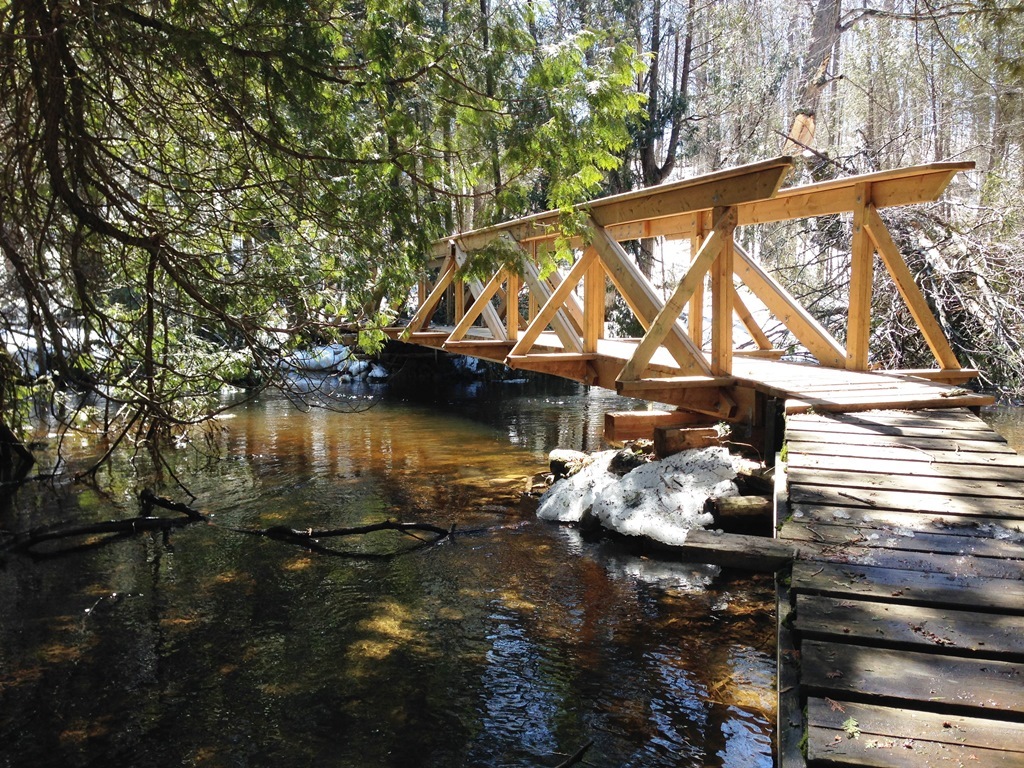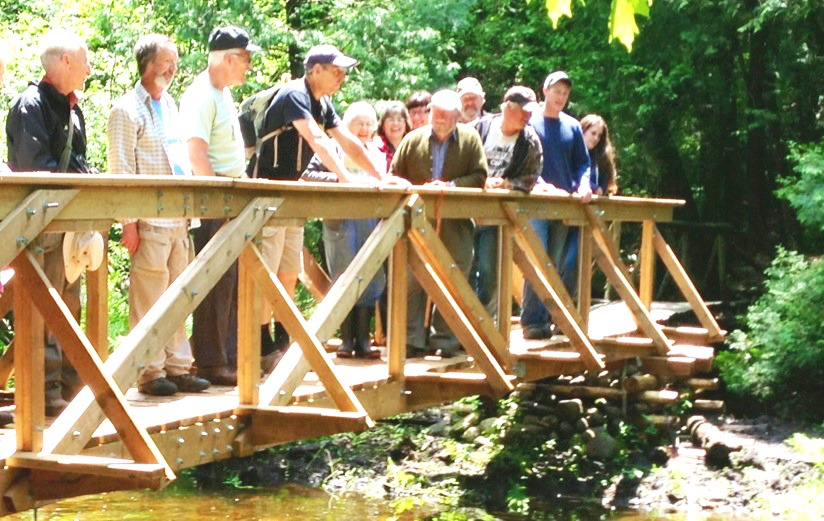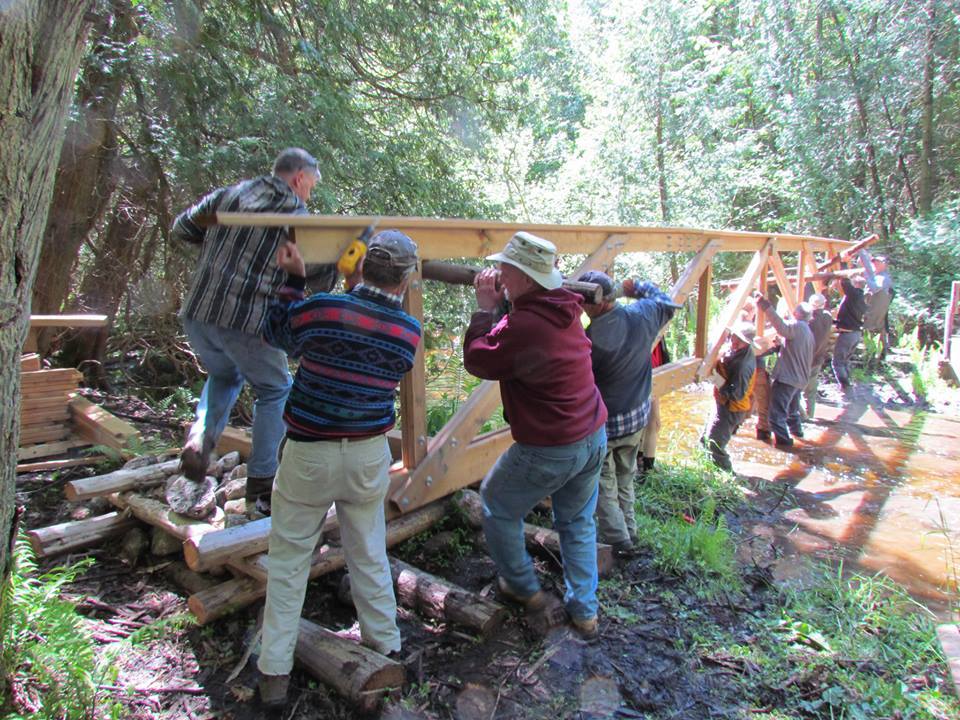|
- Home
- Trails
- Year of the Bridges
- Cove Valley Bridge
Cove Valley Bridge
By Liam Waterman, GHTC Volunteer

The Cove Valley Bridge, which spans an unnamed tributary of Blue Springs Creek intersecting section 3 of the Radial Line Trail (RLT), was installed by the Guelph Hiking Trail Club (GHTC) in 2013 as the culmination of a multi-year bridge building and designing project.1 The wooden truss bridge, designed by retired engineers Phil Kidston and Alan Ferguson, replaced a previous footbridge that had deteriorated due to the periodic flooding experienced by the stream in the springtime.2 Although the project was funded and largely undertaken by GHTC members, it also benefited greatly from the assistance of a number of external volunteers, including the Parker family, who own the property through which this section of the RLT passes. The bridge continues to be a source of pride for the GHTC, being possibly the most personally intensive bridge-building project ever undertaken by members of the club.
The original footbridge over this tributary was installed by the GHTC sometime in the early 1970s, only shortly after the RLT itself (the club’s very first trail) was completed in 1971.3 The bridge was originally 24 feet long, with a relatively simple design, consisting of 2 x 6 inch decking boards laid over larger plank stringers, with wooden abutments on either side. The bridge also had an adjoining boardwalk covering a wet area on the east side of the stream, which was made of similar decking boards laid over cedar logs. Despite its relatively long tenure, this bridge suffered continual deterioration due to flooding caused by spring breakup of snow and ice. The bridge was frequently shifted out of place by the current, and its abutments, which were made of stacks of cedar logs, were particularly vulnerable to being washed away. Over time this flooding also eroded the banks of the stream itself, such that in the year 2000 the bridge had to be extended from 24 feet to 32 feet in order to continue to span the entire tributary. Although the newly lengthened bridge continued to work surprisingly well, it began to exhibit several structural problems within the 2000s. Since the edges of the wooden abutments facing upstream had gradually washed away, the bridge began to lean towards the water on that side.4 A handrail was installed for safety purposes in 2007, which alleviated this problem somewhat. The bridge also began to sag inward at the center, which may have been related to the previous lengthening. Jim Hoare, who had taken over as Trail Captain of section 3 of the RLT by this time, found that the bridge could become entirely encapsulated in ice and snow during the winter. It became clear during this period that some kind of solution was needed.
During the winter of 2011, GHTC member and retired engineer Phil Kidston, who was also Trail Captain of the nearby section 5 of the RLT, began to consider the possibility of strengthening the existing bridge. Kidston sought the assistance of his friend Alan Ferguson, a retired civil engineer with experience in wood frame design and construction. The two of them agreed that the bridge could not be satisfactorily reinforced, and that a new structure would be necessary. They created a preliminary design for a replacement footbridge which would utilize a wooden truss system built into the bridge’s handrails. The triangular structures of truss bridges work to distribute stress evenly over their supporting beams, allowing them to handle a significant amount of weight relative to their mass.5 This new truss bridge would be 38 feet long, and would sit on stone cribs placed on either side of the bank, each of which would consist of a square frame of stripped cedar logs filled with rocks. This design would both elevate the bridge above spring flooding and give it the strength to withstand adverse conditions in the stream. The design was inspired by several footbridges that Kidston had seen at national parks in Newfoundland, particularly Gros Morne National Park, which utilizes several similar wooden truss bridges. For the crib design Kidston had sought advice from the Caledon Hills Bruce Trail Club, which he is also involved with. Kidston proposed the installation of this new bridge over the tributary to the GHTC’s board of executives in 2012, who approved the project, along with its $2,500 to $3,000 preliminary budget.6 The landowners were also supportive of the project.
The construction of the bridge began with the stone cribs in the Fall of that same year. Kidston had previously surveyed the stream valley and decided that the area of the original bridge remained the most well-suited location for bridge construction. He went again to the stream in 2012 with Alan Ferguson and GHTC member John Duthrie to determine the precise location of the new bridge, which they decided would be installed slightly upstream from the original. Subsequently Alan Ferguson devised a final design for the bridge appropriate to the width of the tributary at the proposed location, and Kidston prepared both drawings and lists of parts to be used in construction of the trusses. Construction on the cribs began with a small work party which was responsible for cutting cedar logs, debarking them, and then bolting them together to create two four foot square frames on either bank. This party received assistance from Tom Parker, a member of the Parker family. He frequently felled cedars in the Fall for use as fence posts, and allowed the GHTC volunteers to use his equipment and access a pile of cedar logs that he had already cut. The second phase of construction for the cribs involved filling them up with rocks, which was achieved by a much larger work party using stones relocated from a field boundary on the Parker property. Tom Parker provided assistance again, hauling the stones to the bridge location by means of a trailer attached to his ATV. His contributions made this step significantly quicker and easier for the GHTC.
The second step in constructing the bridge was prefabricating the trusses, which was done by Phil Kidston and Jim Hoare over a period of four weeks in April of 2013. For a space to work on and store the trusses the GHTC received permission to use Mark and Penny Ishoy’s utility shed, which was located close by on Fifth line Nassagaweya. John Fisher (then trail coordinator for the RLT) was responsible for setting up this arrangement; he also lived on Fifth Line, and was friends with Mark, having ran with him in the past. Lumber was delivered directly to the utility shed, and Phil Kidston cut most of it to the required specifications in early April. Jim Hoare assisted primarily with the assembly, bracing, and bolting together of these pieces. Both trusses were constructed in their entirety and then were partially disassembled into three sections to be brought to location.
The installation of the bridge occurred over the course of the weekend of May 25th and 26th, 2013.7 On the first day the trusses were brought to the stream and lifted onto the stone cribs, an endeavor dubbed “the big lift” by the GHTC. John Fisher had arranged for the prefabricated trusses to be brought from the Ishoy’s garage to the Parker Property free of charge by Leathertown Lumber, who had also been contracted to deliver the decking boards. Tom Parker, with the assistance of his son Adam Parker, then moved the trusses to the east side of the stream on the back of an improvised cedar post trailer attached to his ATV. A large number of volunteers were organized to help lift them, including both GHTC members and members of the local running community, particularly from the Guelph Victors Running Club. The GHTC also posted a notice about the work party on the online site Meetup, which was found by a group of young adults from the Kitchener-Waterloo area who also came to the property to assist with the lift. The volunteers began getting the trusses ready before 9:00 am that morning, a process which involved both bolting the sections back together and attaching boards for the handrails. By 10 am the trusses were ready to be installed. After the first truss was placed, several planks were used to brace it against the original bridge while the second truss was lifted. Once both were put in place, a number of preliminary decking boards were laid across and the bridge was deemed structurally secure.
Once the installation of the trusses was finished, the work party had to decide what to do with the old bridge. Rather than deconstructing it, they elected to reutilize it as a boardwalk approach on the west side of the stream. To this end the old bridge was lifted into position adjoining the new bridge, where it remains today. The old boardwalk was also rebuilt to align with the orientation of the new bridge. Work was completed around 4 pm. The subsequent day a small group of GHTC members came out to complete the installation of the decking boards along with some further structural securing of the bridge. This work, which also included cleaning up the work site, extended into the following Monday (May 27th) but was finished without any hitches. Once this process was finished, the replacement bridge building project was deemed complete.
An official opening for the bridge, which was at the time known only as the Parker Bridge, was held on June 2nd, 2013. It was attended by many of the individuals who had contributed significantly to the bridge building project, including Alan Ferguson, Phil Kidston, Jim Hoare, John Fisher, Tom Parker, and Adam Parker. Other members of the Parker family also attended, along with GHTC board members, volunteers, and spouses. The bridge was later renamed to the “Cove Valley Bridge”, after the Parker family’s farm. Yearly inspection and maintenance of the bridge has been undertaken since then by Jim Hoare. In order to ensure that the bridge has not lost its arch, Jim runs a flat line of string from one end of the bridge to the other and then measures the distance between the center of the string and the center of the bridge. Jim is also required to tighten the nuts on the metal rods supporting the trusses, some of which can only be accessed from underneath the bridge, requiring him to wade into the stream. For more than a decade now the bridge has held up remarkably well with little need for maintenance. Shortly after its installation Jim also created several laminated booklets showcasing pictures of the previous bridge and the process of bridge construction. He has used these in his role as hike leader to help show trail users how the bridge came to be.
The Cove Valley Bridge has remained a source of pride to many. John Fisher, now president of the GHTC, recalls seeing many of the volunteers who had contributed to “the Big Lift” visiting the bridge in the days after, showing their spouses or family members the finished product. On June 10th, 2023, the GHTC held a 10th anniversary event for the Cove Valley Bridge, which was again attended by many who had originally worked on the bridge a decade prior. Fisher notes that the Cove Valley Bridge project is perhaps the longest and most complicated bridge project ever completed by the GHTC. He describes it, “a terrific example of bringing a whole bunch of people, or connections, together, and a great example of working with a landlord.”8 Benefiting from the assistance of a variety of different groups and individuals, including the Parker family, the Ishoys, Leathertown Lumber, the volunteers contacted via Meetup, and the local running community, the Cove Valley Bridge constitutes a prime example of the power of community connections.

Notes
1. In researching this article I had the privilege to interview several individuals involved with the construction of the Cove Valley Bridge, including Phil Kidston, Jim Hoare, and John Fisher. Thanks are owed to them for a great deal of the information in this article.
2. Fisher, John. “Radial Line Trail Bridge Replacement,” Guelph Hiking Trail Club Newsletter41, no. 2 (2013): 5, https://issuu.com/doberman_xy/docs/ghtc_41_2_web.
3. “Club History,” Guelph Hiking Trail Club, https://www.guelphhiking.com/History.
4. Fisher, John. “Radial Line Trail Bridge Replacement,” Guelph Hiking Trail Club Newsletter 41, no. 2 (2013): 5, https://issuu.com/doberman_xy/docs/ghtc_41_2_web.
5. “What is a Truss Bridge?”, Tennessee Department of Transportation, accessed August 26th, 2023, https://www.tn.gov/tdot/structures-/historic-bridges/what-is-a-truss-bridge.
6. Fisher, John. “Radial Line Trail Bridge Replacement,” Guelph Hiking Trail Club Newsletter 41, no. 2 (2013): 5–6, https://issuu.com/doberman_xy/docs/ghtc_41_2_web.
7. Ibid., 6.
8. In discussion with the author, July 2023.



